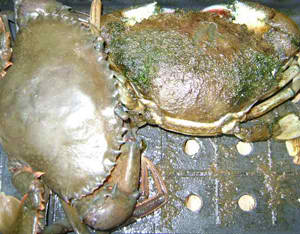The Philippines is the world’s second top producer of mud crab (also known as mangrove crab).

The Philippines prides itself as the world’s second top producer of mangrove crab (Photo from the Inland Aquatic Resources Research Division, PCAARRD)
Production is done using polyculture system (or the combination of several species) in 30% of brackishwater ponds in the country. However, supply of crablets for farming is still sourced from the wild. The industry is estimated to require 36-45 million crablets annually.
While the Philippines has been a pioneer in developing the basic technology for mangrove crab hatchery, the commercialization of the technology is constrained by high production cost, lack of formulated diet and inconsistent survival due to diseases. In the nursery, the major problem is cannibalism while lack of low-cost and practical formulated diets and diseases are the main issues in the grow-out phase.
Initiated by the Philippine Council for Agriculture, Aquatic and Natural Resources Research and Development of the Department of Science and Technology (DOST-PCAARRD), the Industry Strategic S&T Program (ISP) for mangrove crab aims to refine the existing technologies for mangrove crab hatchery, nursery and grow-out, and to demonstrate the economic viability of a commercial mangrove crab hatchery.
Recognizing the high demand of mangrove crab in the local and export markets, DOST-PCAARRD funded the Mangrove Crab S&T Program in 2012. The program, which is implemented by the Southeast Asian Fisheries Development Center/Aquaculture Department (SEAFDEC/AQD) based in Tigbauan, Iloilo, has achieved major accomplishments to boost the mangrove crab industry.
One of the program’s accomplishments is the development of breeding and culture techniques for marine annelid, Marphysa mossambica, to supply the nutritional requirements of mangrove crab broodstock. The said species of worm contains 63.2% crude protein and 0.8% crude fat.
Zoeae (the larva of a crab) from broodstock, fed with 20% pathogen-free annelid in formulated diet contained higher levels of total lipids and highly unsaturated fatty acid (HUFA), which can improve the larval performance. Feeding the zoeae with formulated diets reduced the use of natural food in the hatchery.
Trials conducted under the program showed improved larval survival of 70% during the first trial and 70-90% in the second trial in the nursery.
Under the study, black net arranged like seagrasses was also identified as the most suitable shelter for crablets in the nursery. It provides 60-70% survival rate even at higher density of 50 ind/m2.
A prototype demo hatchery showcasing improved hatchery and nursery protocols was set up in Guindulman, Bohol under SEAFDEC/AQD. The hatchery, which is capable of producing 40,000 crab instar, was turned over to the local government in May 2015.
Trainings on all aspects of mangrove crab culture have been conducted for hatchery operators/owners and their technicians at SEAFDEC/AQD, and for technicians, traders, teachers, and students in selected State College and Universities (SUCs).
Technical assistance on the actual hatchery and nursery rearing was also provided in various sites. Refined hatchery and nursery technologies are currently being adopted by the private sectors, local government units (LGUs), and SUCs in different sites of the country. Most of these hatcheries and nurseries are now producing crablets.
Another accomplishment of the program was the formulation of the right basal diet for grow-out culture. The diet contains 48% crude protein (CP), 8% crude fat and dietary energy of 1723 MJ/kg diet.
Training participants stock crab instar in nursery ponds at SEAFDEC/AQDs Dumangas Brackishwater Station (Photo from www.seafdec.org.ph)
In another development, the program also yielded information that synthetic binders are more effective than the natural feed binders. According to the study, synthetic binders make pellet more stable in the water for up to 24 hours. Pilot testing with commercial feed companies is still ongoing.
Crab culture trials in collaboration with the private sector in Pontevedra, Capiz and Barotac Nuevo, Iloilo are also ongoing test potential feeding and management strategies in pens and ponds.
Six immunostimulants (three locally made from seaweed extracts – Ulva, Sargassum and Padina and three from commercial sources – peptidoglycan, mannan, and ergosan) have been optimized in terms of dose and frequency, and to elicit antiviral response to attain 70% survival against White Spot Syndrome Virus (WSSV) infection.
The program also led to the development of protocols for the production of soft-shelled crab using hatchery-reared mangrove crab juveniles.
With these developments and refinements of technologies, it is expected that the Philippines will become the mangrove crab leading producer in the world.
DOST-PCAARRD will showcase mangrove crab including other agri-aqua research and development (R&D) outputs on March 2-4, 2016 during the SIPAG FIESTA at its headquarters in Los Baños, Laguna.
SIPAG, a technology transfer strategy, embodies the Council’s commitment to DOST’s Outcome One in a bid to ensure that the fruits of R&D activities for the agri-aqua sectors will be a blessing for every Juan.
by Inland Aquatic Resources Research Division, DOST-PCAARRD

